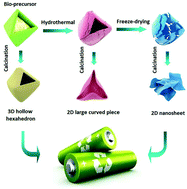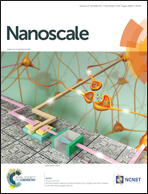From a 3D hollow hexahedron to 2D hierarchical nanosheets: controllable synthesis of biochemistry-enabled Na7V3(P2O7)4/C composites for high-potential and long-life sodium ion batteries†
Abstract
Tailoring materials into different structures offers unprecedented opportunities in the realization of their functional properties. Particularly, controllable design of diverse structured electrode materials is regarded as a crucial step towards fabricating high-performance batteries. Herein, a general biochemistry-directed strategy has been developed to fabricate functional materials with controllable architectures and superior performance. The natural structure of fern (i.e. Cibotium) spores realizes the formation of a three-dimensional hexahedral bio-precursor. Either its core or shell is targeted to be destroyed, resulting in different architectures, from a 3D hollow hexahedron to a 2D hierarchical nanosheet, of the final product. As a case study, sodium vanadium pyrophosphate (i.e. Na7V3(P2O7)4) is employed as the electrochemically active material in this study. The crucial role of controllable damage in the construction of diverse architectures is discussed. Moreover, the relationship between different outside architectures, internal microstructures and the sodium intercalation capabilities of the bio-composites is clarified. Among all the samples, the 2D nanosheet with hierarchical structures has the smallest particle size and the highest surface area, which are favourable for its fast sodium intercalation. As a result, it is capable of high-rate long-term cycling, which achieves a high cycling efficiency of 93% after 500 cycles at 20C. However, a 3D hollow hexahedron has a thick shell and inferior surface characteristics, which greatly limits its sodium transport kinetics and leads to inferior performance. Therefore, the present work not only highlights a general, green and energy-efficient biochemistry-enabled strategy to prepare high-performance electrode materials, but also provides clues to controllably design diverse architectures for functional materials.


 Please wait while we load your content...
Please wait while we load your content...